An Experimental Study on Dynamic Mechanical Properties of Fiber-Reinforced Concrete under Different Strain Rates
Abstract
1. Introduction
2. The Sample Preparation for the FRC with PVA
2.1. Experimental Materials and Production
2.1.1. PVA Fiber
2.1.2. Mixture Design Proportions and Mixing of FRC
2.2. Experimental Program
3. Experimental Results and Discussion
3.1. Compression Strength
3.2. Split Tensile Strength
3.3. Elastic Modulus and Peak Strain
3.4. Deformation Characteristics
3.5. Toughness Index
4. Conclusions
- (1)
- PVA has some enhancement and improvement effects on the concrete, mainly regarding the improvement of the compressive strength, splitting tensile strength, the toughness index, and the post-peak mechanical properties of the stress and strain curves at the descending stage. The addition of PVA can also significantly improve the failure behavior of the concrete, which changes from the fall-block and caving of plain concrete to a relatively complete form of FRC with a residual strength of 3–5 MPa. The enhancing effect of PVA on the concrete differs for two matrix strengths. The lower the matrix strength, the more obvious the reinforcing effect of the fiber is on the concrete.
- (2)
- PVA FRC is a rate-sensitive material similar to plain concrete. The uniaxial compressive strength, splitting tensile strength, and elastic modulus of concrete increase with increasing strain rate, while the peak strain of concrete decreases, indicating that the FRC under a high strain rate is more brittle than that under a low strain rate.
- (3)
- The PVA FRC with a 0.2% volume content has greater advantages than the other two kinds of fiber concrete in improving concrete’s mechanical properties. Considering cost factors and construction convenience, concrete with a 0.2% PVA content is recommended in engineering applications.
Author Contributions
Acknowledgments
Conflicts of Interest
References
- Dong, J.F.; Wang, Q.Y.; Guan, Z.W. Material properties of basalt fibre reinforced concrete made with recycled earthquake waste. Constr. Build. Mater. 2017, 130, 241–251. [Google Scholar] [CrossRef]
- Richardson, A.; Coventry, K. Dovetailed and hybrid synthetic fibre concrete–impact, toughness and strength performance. Constr. Build. Mater. 2015, 78, 439–449. [Google Scholar] [CrossRef]
- Su, H.; Xu, J. Dynamic compressive behavior of ceramic fiber reinforced concrete under impact load. Constr. Build. Mater. 2013, 45, 306–313. [Google Scholar] [CrossRef]
- Yan, Z.; Zhu, H.; Ju, J.W. Behavior of reinforced concrete and steel fiber reinforced concrete shield TBM tunnel linings exposed to high temperatures. Constr. Build. Mater. 2013, 38, 610–618. [Google Scholar] [CrossRef]
- Asokan, P.; Osmani, M.; Price, A.D.F. Assessing the recycling potential of glass fibre reinforced plastic waste in concrete and cement composites. J. Clean. Prod. 2009, 17, 821–829. [Google Scholar] [CrossRef]
- Song, P.S.; Hwang, S. Mechanical properties of high-strength steel fiber-reinforced concrete. Constr. Build. Mater. 2004, 18, 669–673. [Google Scholar] [CrossRef]
- Yazici, Ş.; İnan, G.; Tabak, V. Effect of aspect ratio and volume fraction of steel fiber on the mechanical properties of SFRC. Constr. Build. Mater. 2007, 21, 1250–1253. [Google Scholar] [CrossRef]
- Vajje, S.; Krishnamurthy, N.R. Study on addition of the natural fibers into concrete. Int. J. Sci. Technol. Res. 2013, 2, 213–218. [Google Scholar]
- Sivaraja, M.; Velmani, N.; Pillai, M.S. Study on durability of natural fibre concrete composites using mechanical strength and microstructural properties. Bull. Mater. Sci. 2010, 33, 719–729. [Google Scholar] [CrossRef]
- Agopyan, V.; Savastano, H., Jr.; John, V.M.; Cincotto, M.A. Developments on vegetable fibre–cement based materials in São Paulo, Brazil: An overview. Cem. Concr. Compos. 2005, 27, 527–536. [Google Scholar] [CrossRef]
- Ali, M.; Liu, A.; Sou, H.; Chouw, N. Mechanical and dynamic properties of coconut fibre reinforced concrete. Constr. Build. Mater. 2012, 30, 814–825. [Google Scholar] [CrossRef]
- Shafiq, N.; Ayub, T.; Khan, S.U. Investigating the performance of PVA and basalt fibre reinforced beams subjected to flexural action. Compos. Struct. 2016, 153, 30–41. [Google Scholar] [CrossRef]
- Grote, D.L.; Park, S.W.; Zhou, M. Dynamic behavior of concrete at high strain rates and pressures: I. experimental characterization. Int. J. Impact Eng. 2001, 25, 869–886. [Google Scholar] [CrossRef]
- Malvar, L.J.; Ross, C.A. Review of strain rate effects for concrete in tension. ACI Mater. J. 1998, 95, 735–739. [Google Scholar]
- Soufeiani, L.; Raman, S.N.; Jumaat, M.Z.B.; Alengaram, U.J.; Ghadyani, G.; Mendis, P. Influences of the volume fraction and shape of steel fibers on fiber-reinforced concrete subjected to dynamic loading—A review. Eng. Struct. 2016, 124, 405–417. [Google Scholar] [CrossRef]
- Abrams, D.A. Effect of rate of application of load on the compressive strength of concrete. Proc. ASTM 1917, 17, 364–377. [Google Scholar]
- Cook, D.J.; Pama, R.P.; Weerasingle, H. Coir fibre reinforced cement as a low cost roofing material. Build. Environ. 1978, 13, 193–198. [Google Scholar] [CrossRef]
- Zhang, X.X.; Abd Elazim, A.M.; Ruiz, G.; Yu, R.C. Fracture behaviour of steel fibre-reinforced concrete at a wide range of loading rates. Int. J. Impact Eng. 2014, 71, 89–96. [Google Scholar] [CrossRef]
- Jiang, C.; Fan, K.; Wu, F.; Chen, D. Experimental study on the mechanical properties and microstructure of chopped basalt fibre reinforced concrete. Mater. Des. 2014, 58, 187–193. [Google Scholar] [CrossRef]
- Deng, Z. High Performance Synthetic Fiber Concrete; Science Press: Beijing, China, 2003. [Google Scholar]
- Holschemacher, K.; Höer, S. Influence of PVA fibers on load carrying capacity of concrete with coarse aggregates. In Proceedings of the 7th International RILEM Symposium on Fibre Reinforced Concrete: Design and Applications, Chennai, India, 17–19 September 2008; pp. 219–229. [Google Scholar]
- Tosun-Felekoğlu, K.; Felekoğlu, B.; Ranade, R.; Lee, B.Y.; Li, V.C. The role of flaw size and fiber distribution on tensile ductility of PVA-ECC. Compos. Part B Eng. 2014, 56, 536–545. [Google Scholar] [CrossRef]
- Suryanto, B.; Maekawa, K.; Nagai, K. Predicting the Creep Strain of PVA-ECC at High Stress Levels based on the Evolution of Plasticity and Damage. J. Adv. Concr. Technol. 2013, 11, 35–48. [Google Scholar] [CrossRef][Green Version]
- Banthia, N.; Mindess, S.; Trottier, J.F. Impact resistance of steel fiber reinforced concrete. ACI Mater. J. 1996, 93, 472–479. [Google Scholar]
- China Academy of Building Research (CABR). JGJ 55-2011: Specification for Mix Proportion Design of Ordinary Concrete; China Architecture Building Press: Beijing, China, 2011. [Google Scholar]
- National Standards of the People’s Republic of China. JG/T472-2015: Steel Fiber Reinforced Concrete; Standards Press of China: Beijing, China, 2015. [Google Scholar]
- Zhang, Y. Experimental Study of the Mechanical Properties of Concrete under Different Strain Rates; Beijing University of Technology: Beijing, China, 2012. [Google Scholar]
- Mihashi, H.; Wittmann, F.H. Stochastic approach to study the influence of rate of loading on strength of concrete. HERON 1980, 25, 1–54. [Google Scholar]
- Fib Model Code. Fib Model Code for Concrete Structures 2010; Ernst Sohn: Berlin, Germany, 2010. [Google Scholar]
- Wu, S.; Chen, X.; Zhou, J. Tensile strength of concrete under static and intermediate strain rates: Correlated results from different testing methods. Nucl. Eng. Des. 2012, 250, 173–183. [Google Scholar] [CrossRef]
- Shah, S.P. Experimental methods for determining fracture process zone and fracture parameters. Eng. Fract. Mech. 1990, 35, 3–14. [Google Scholar] [CrossRef]
- Zhang, H.; Gao, Y.; Li, F. Experimental study on dynamic properties and constitutive model of polypropylene fiber concrete under high strain rate. J. Central South Univ. (Sci. Technol.) 2013, 44, 3464–3473. [Google Scholar]
- Yi, C.; Fan, Y.; Zhu, H.; Wang, J.Q. Research on fatigue damage of concrete under uniaxial compression on the basis of toughness. Eng. Mech. 2010, 27, 113–119. [Google Scholar]
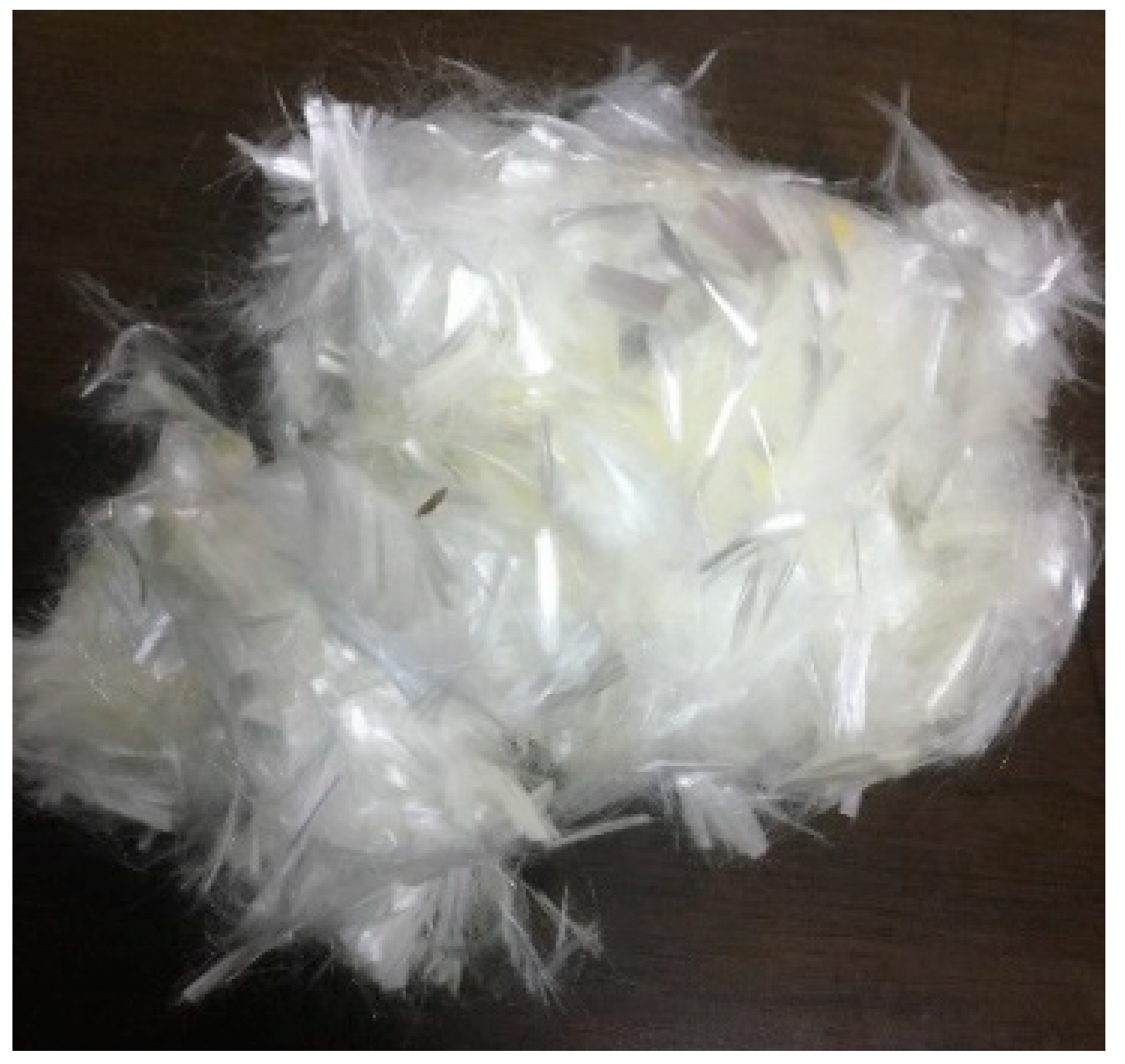
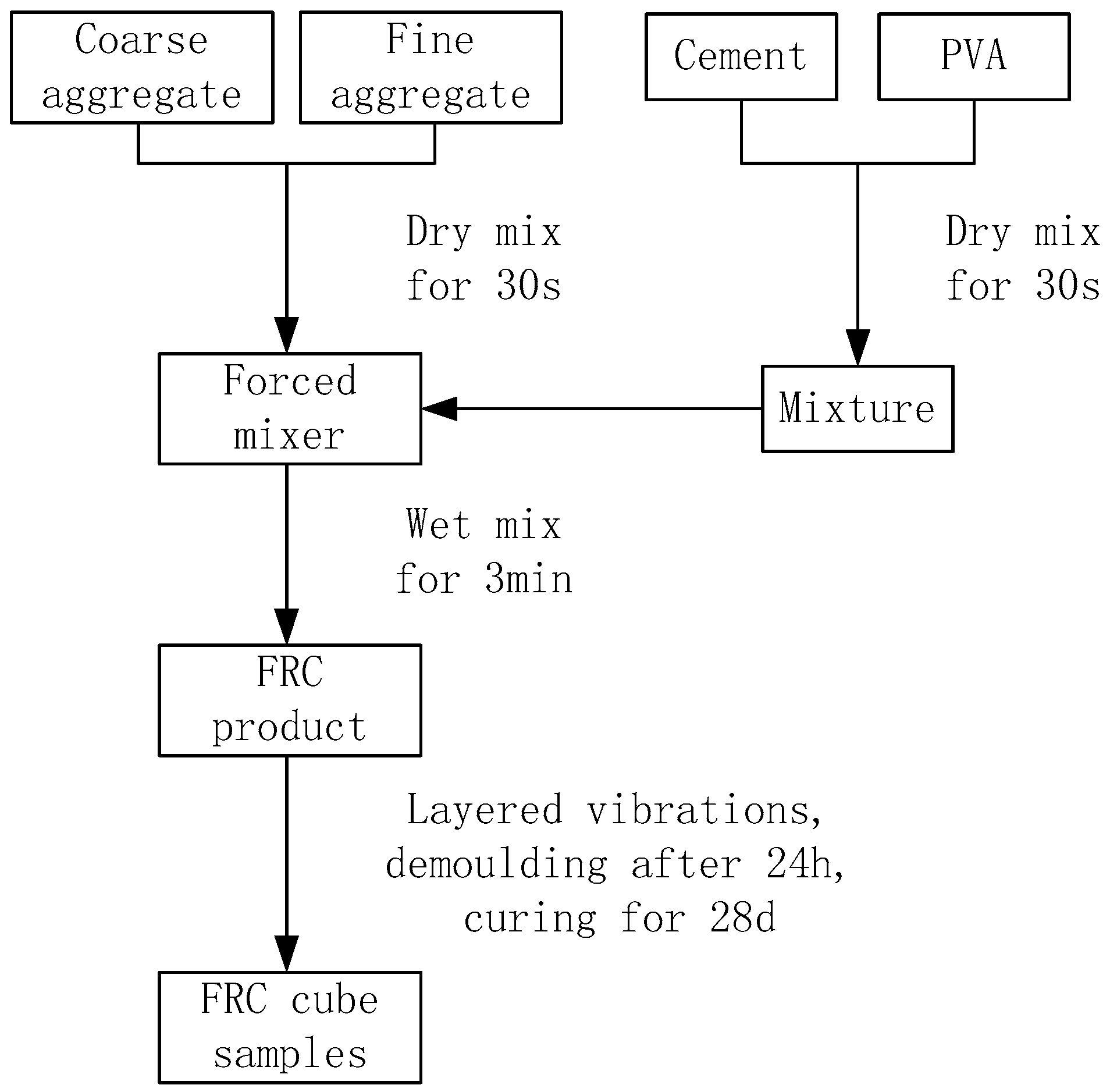
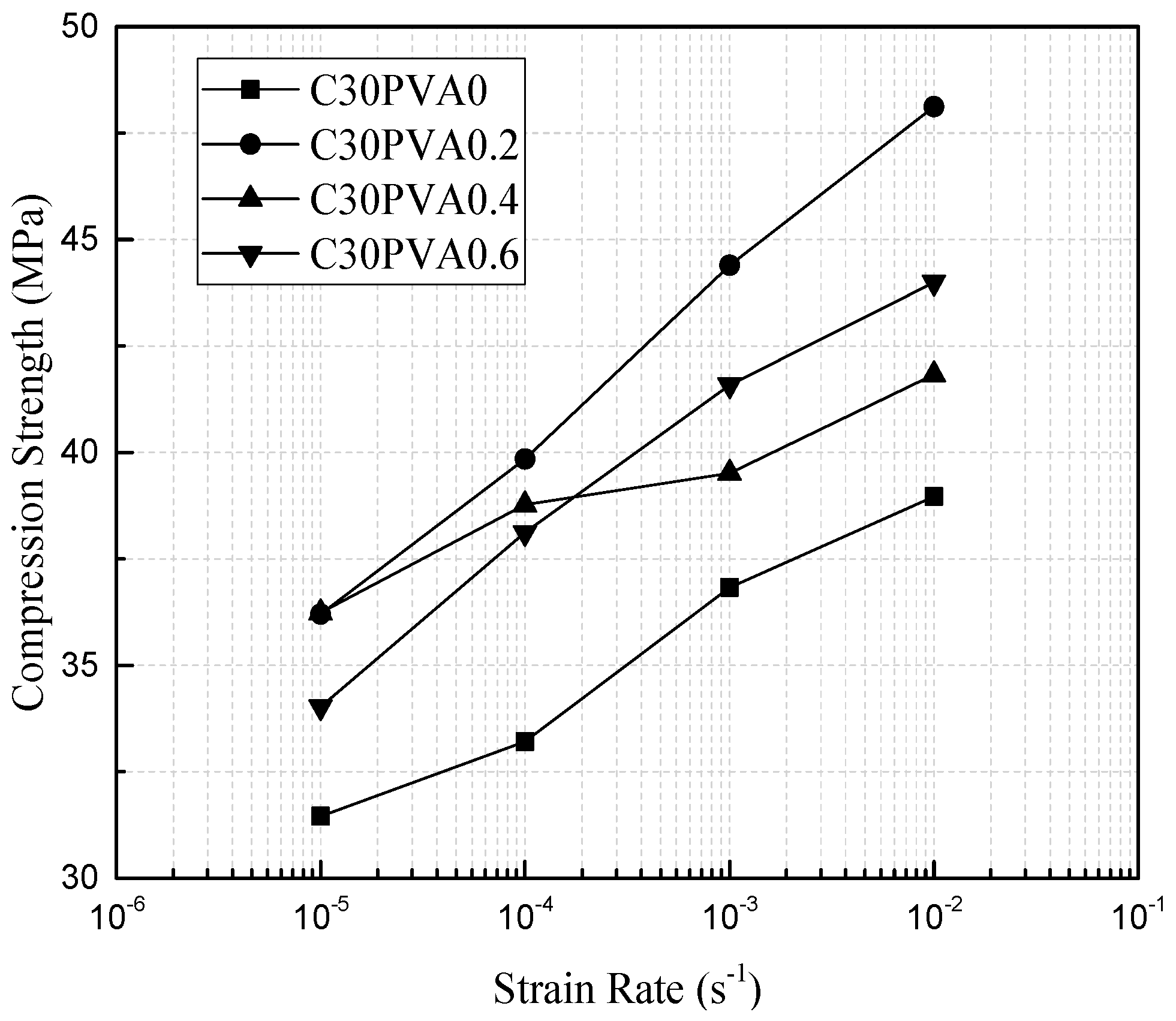

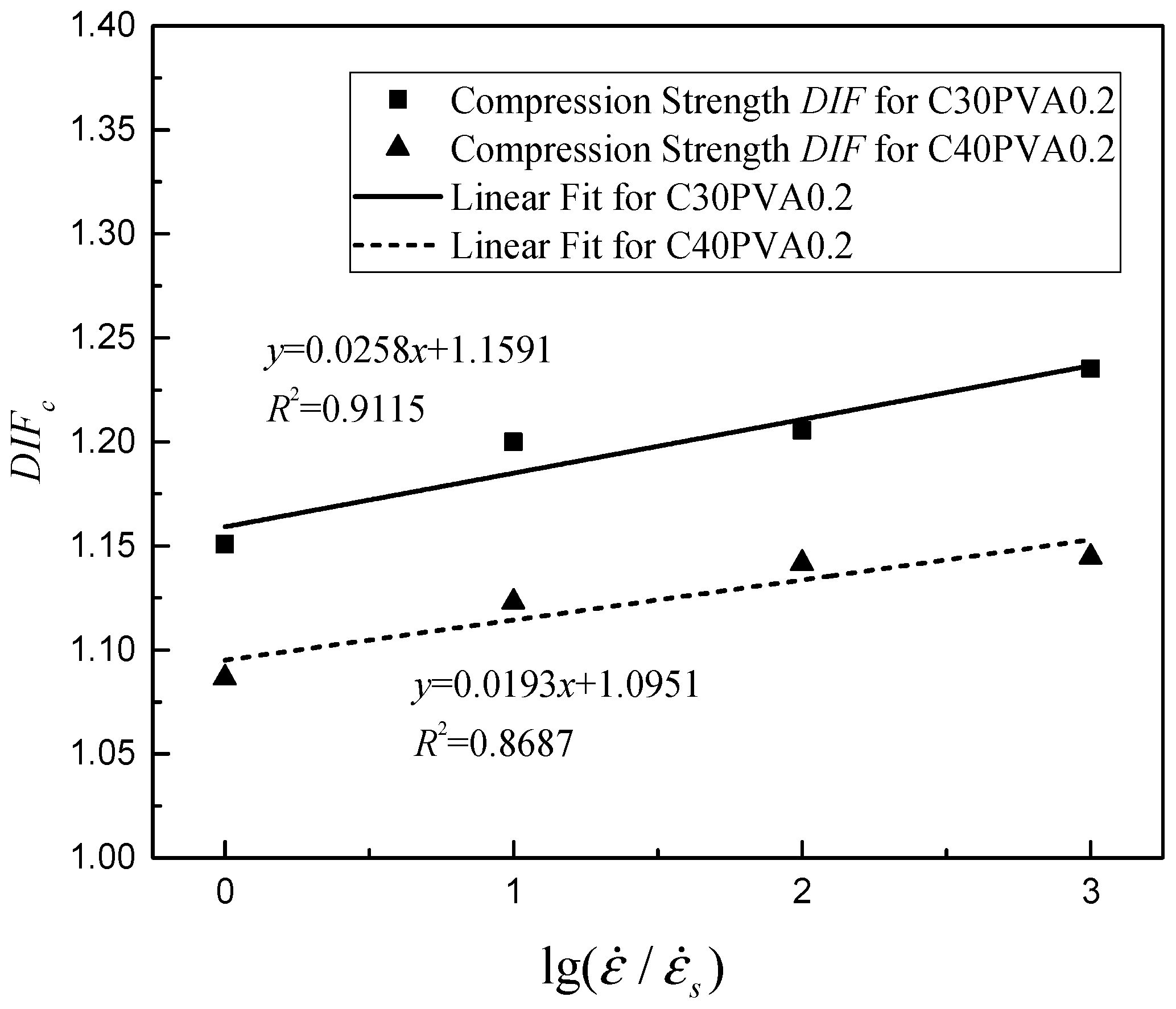
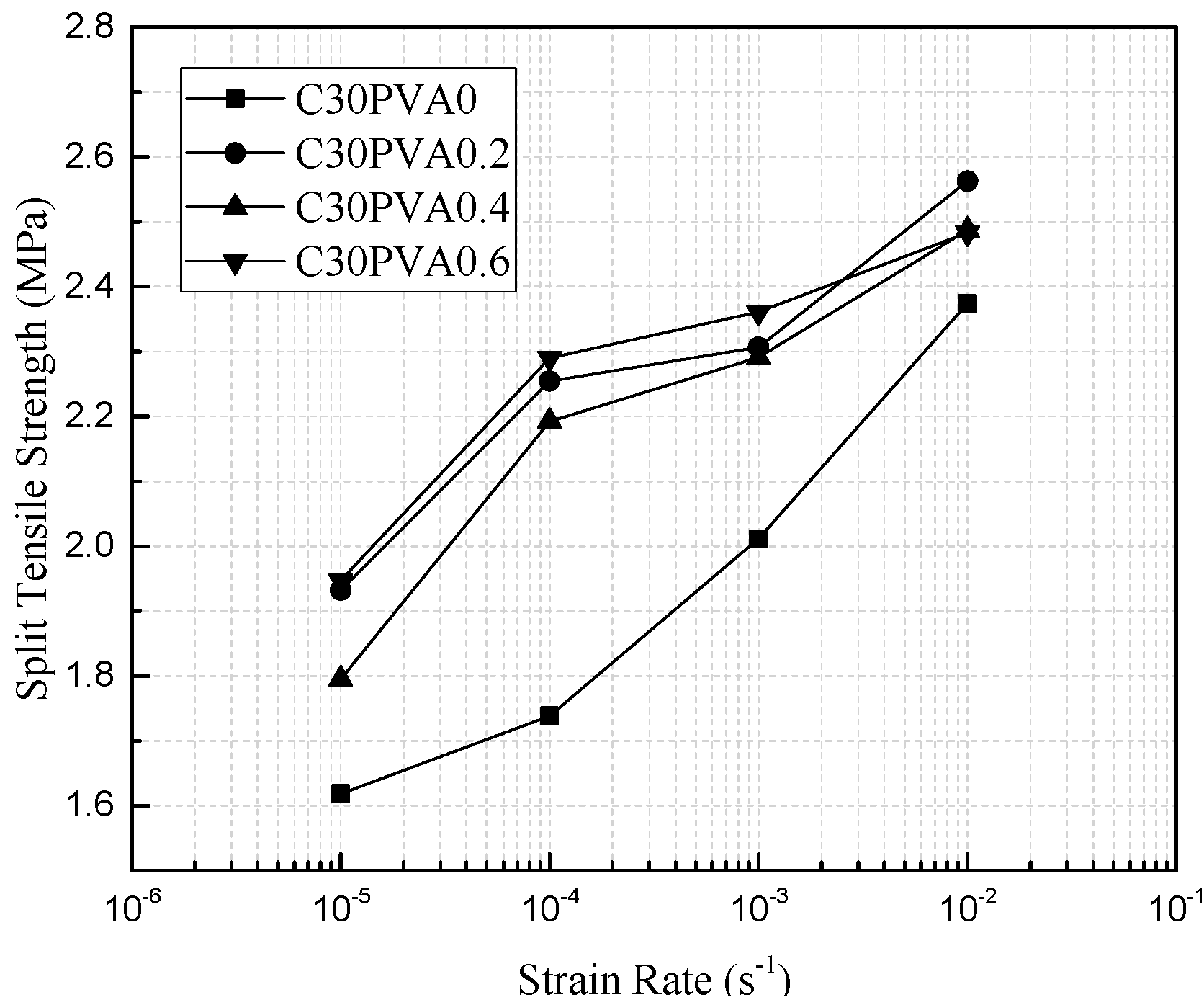
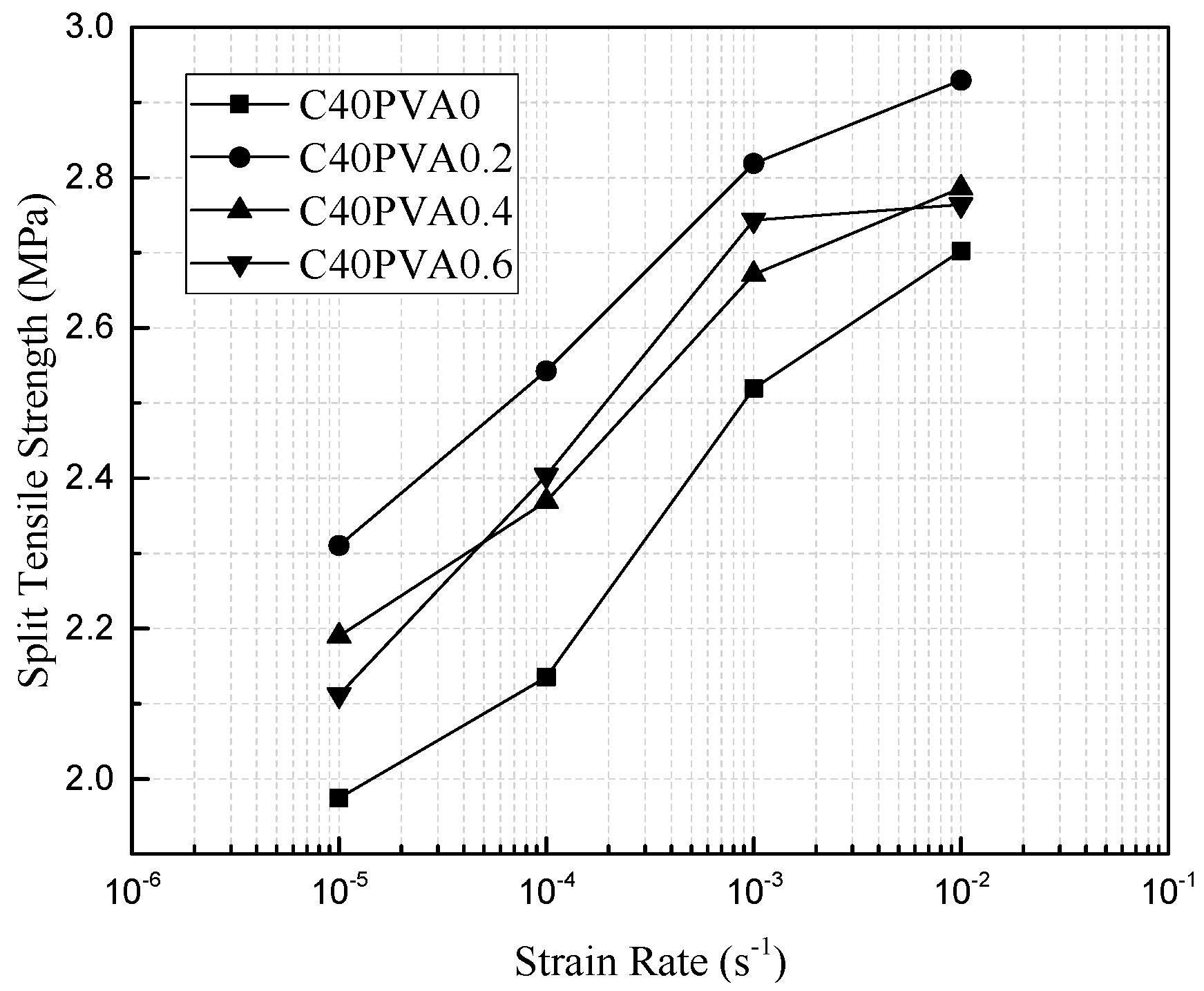
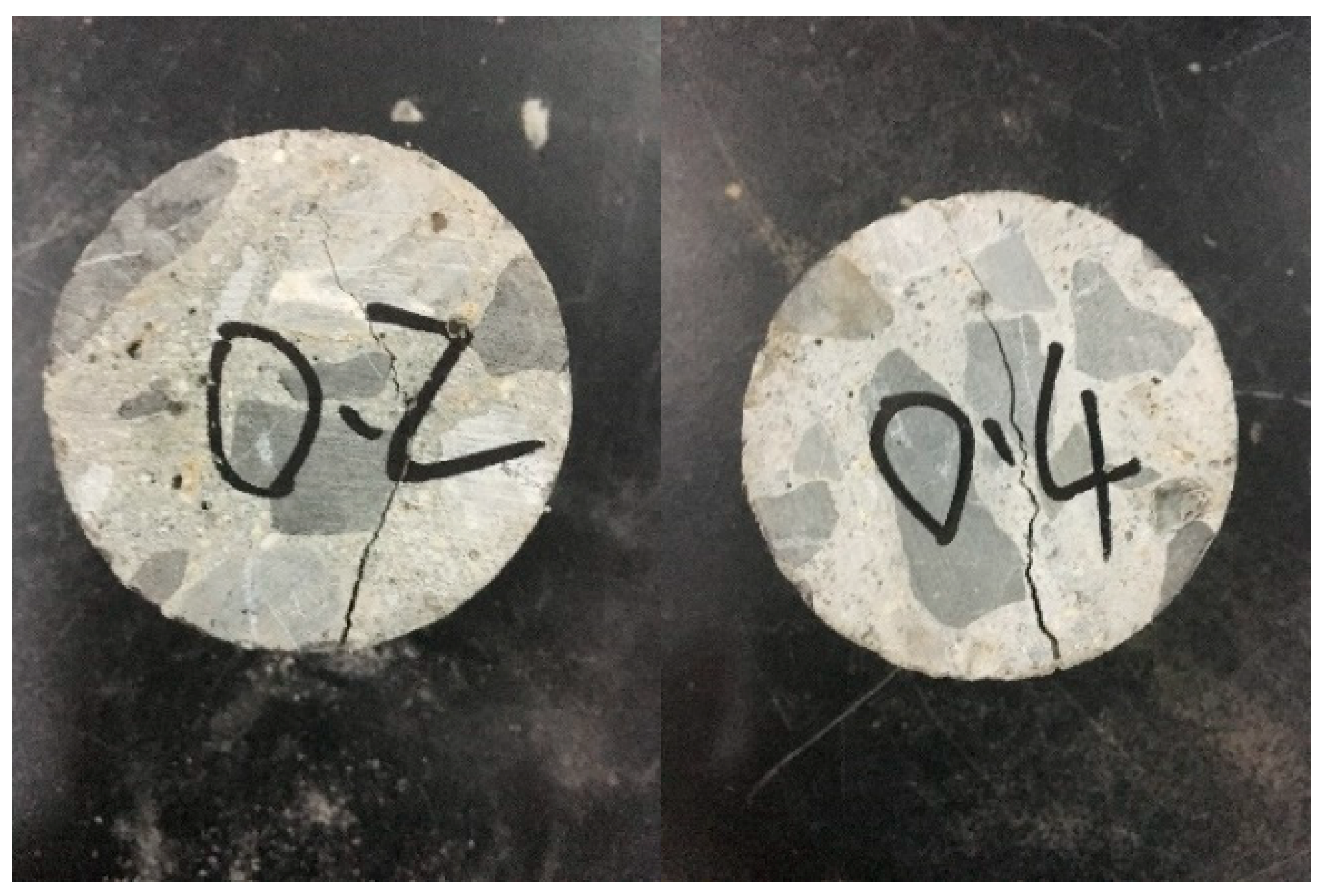
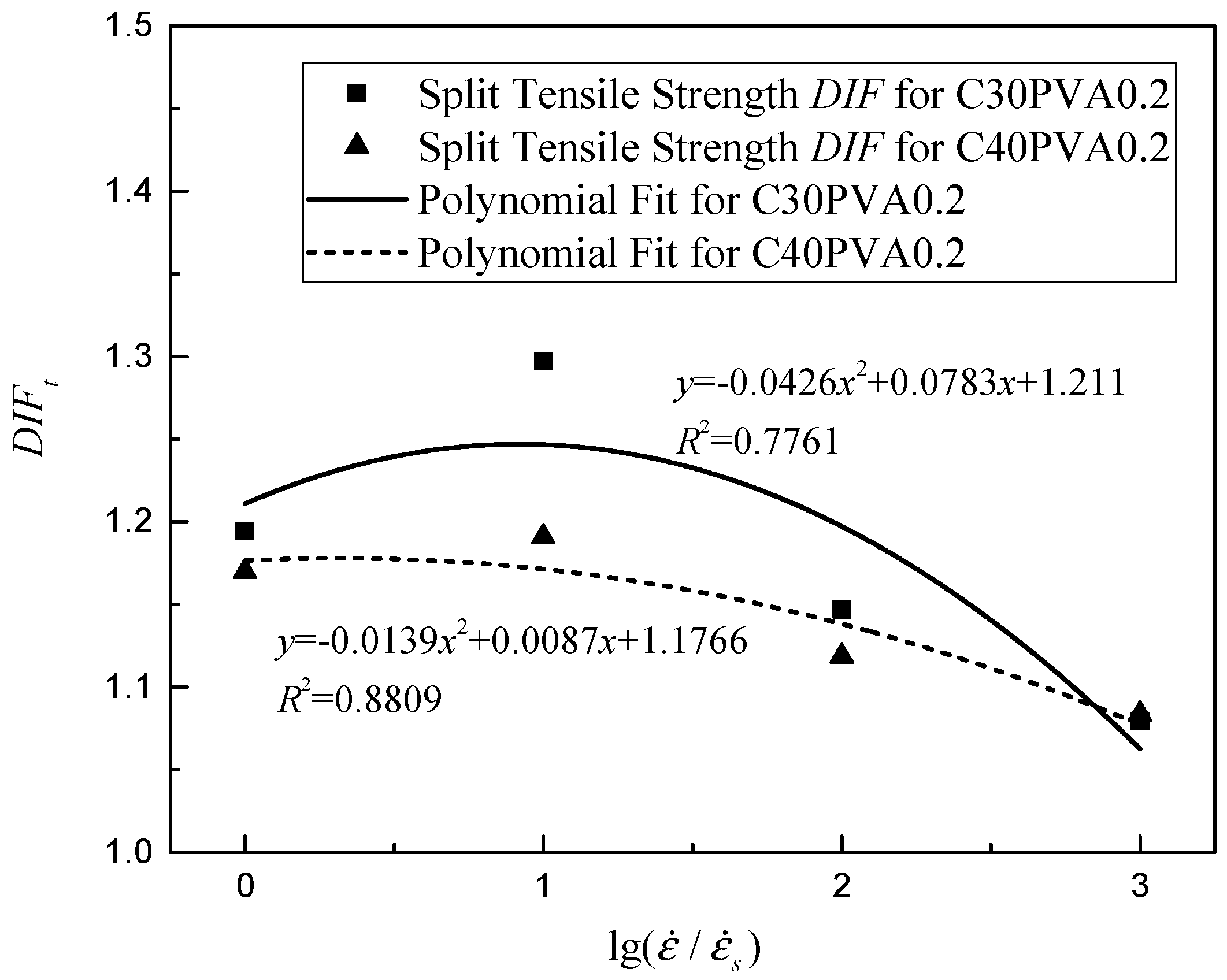
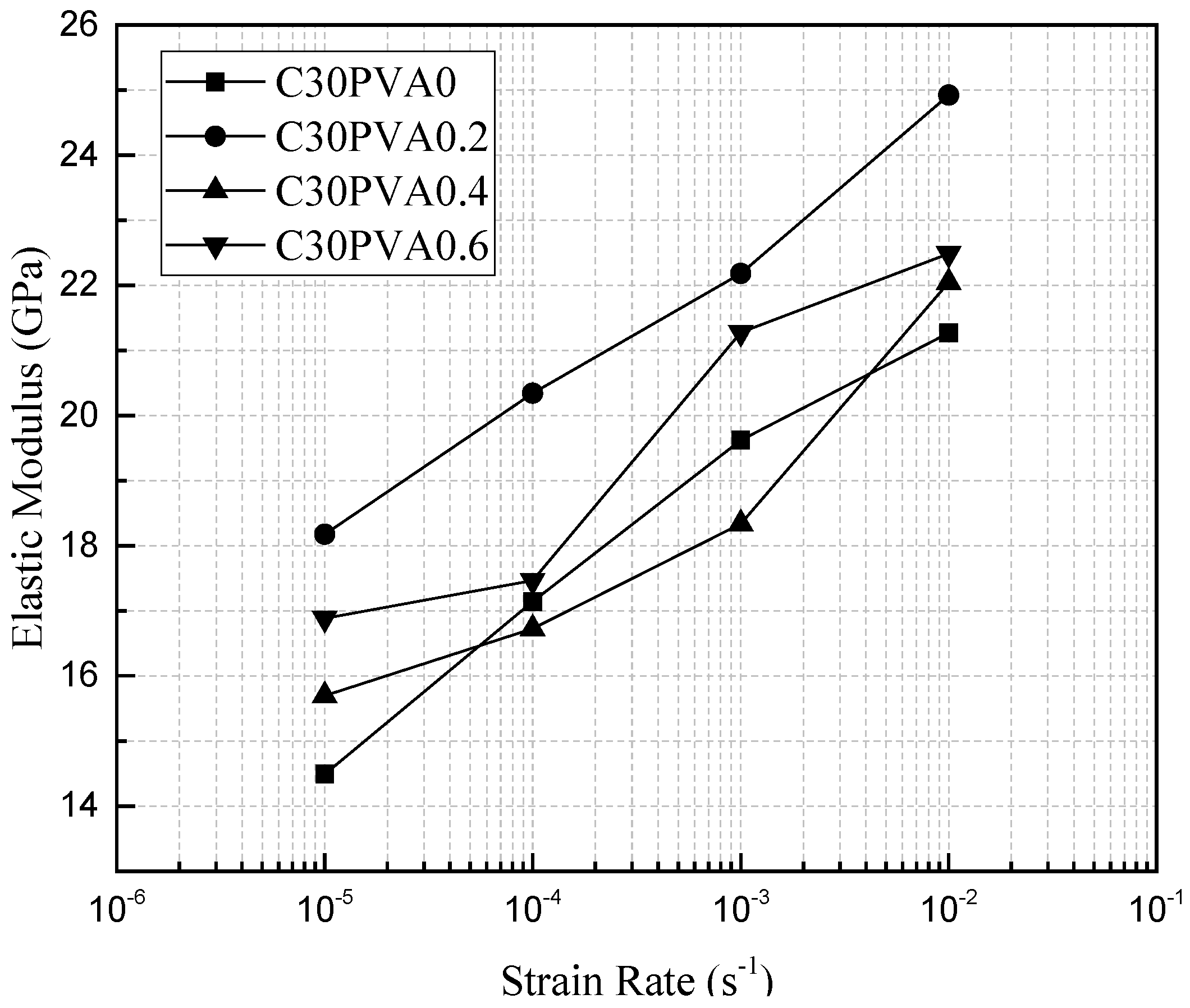
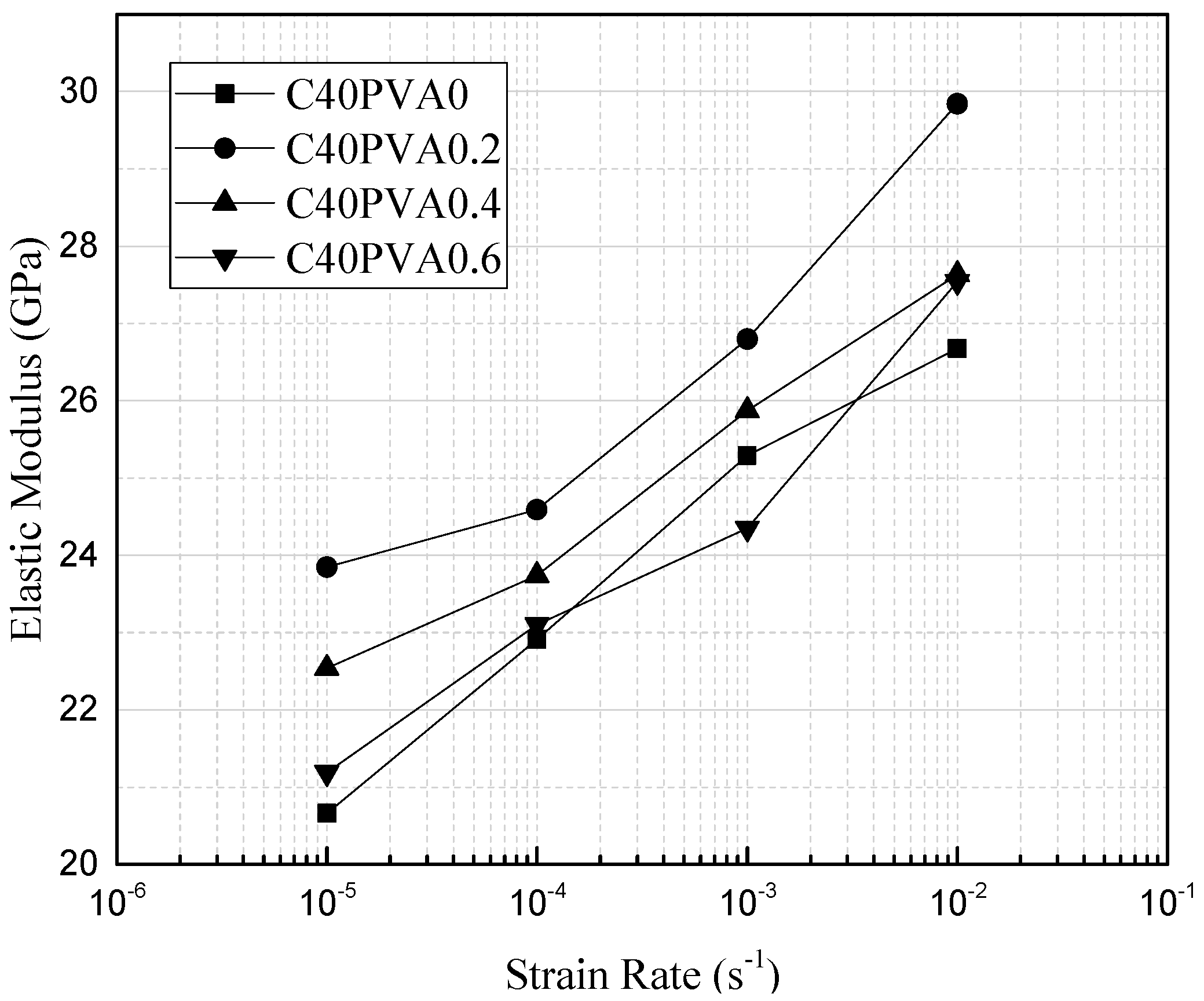
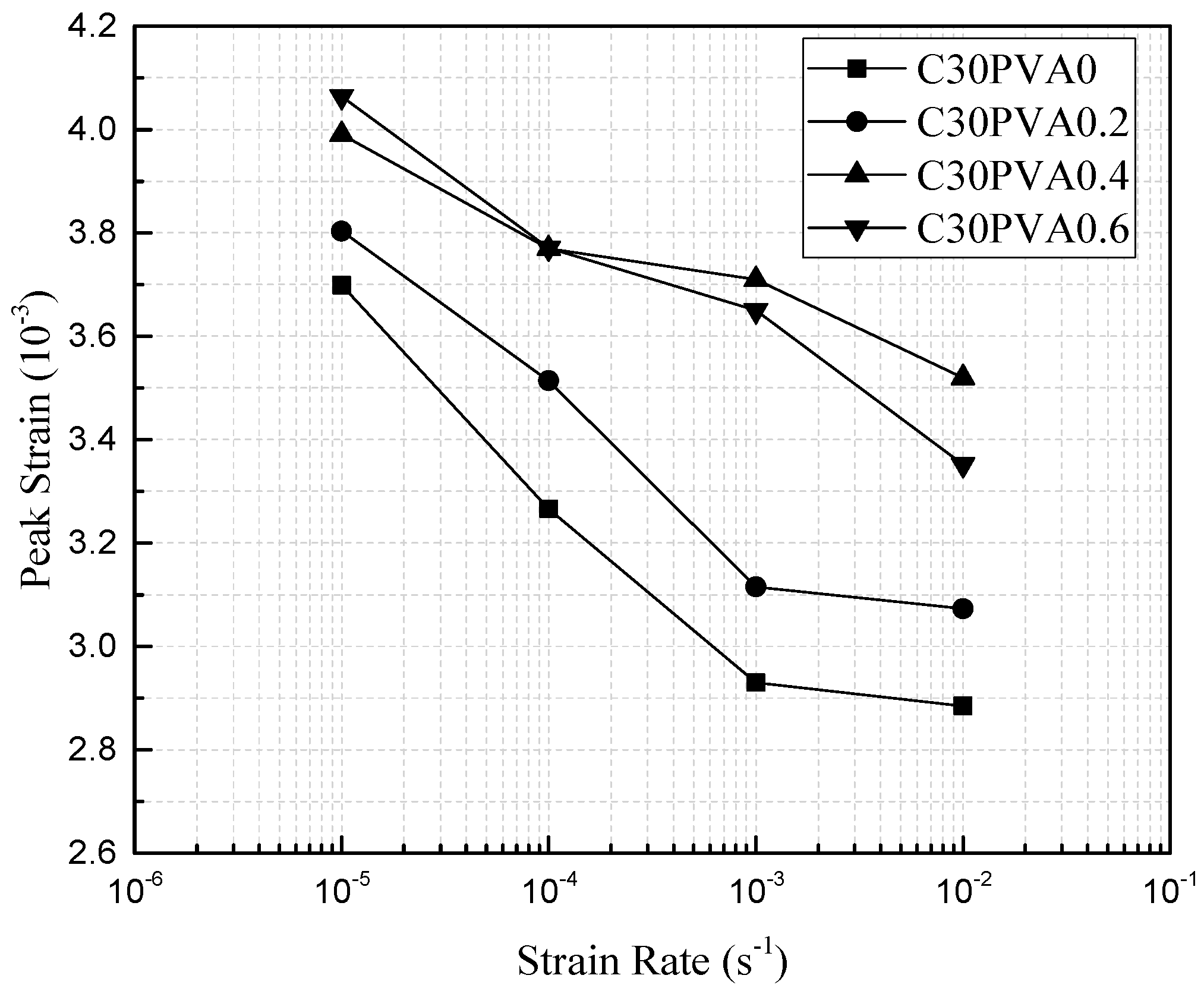
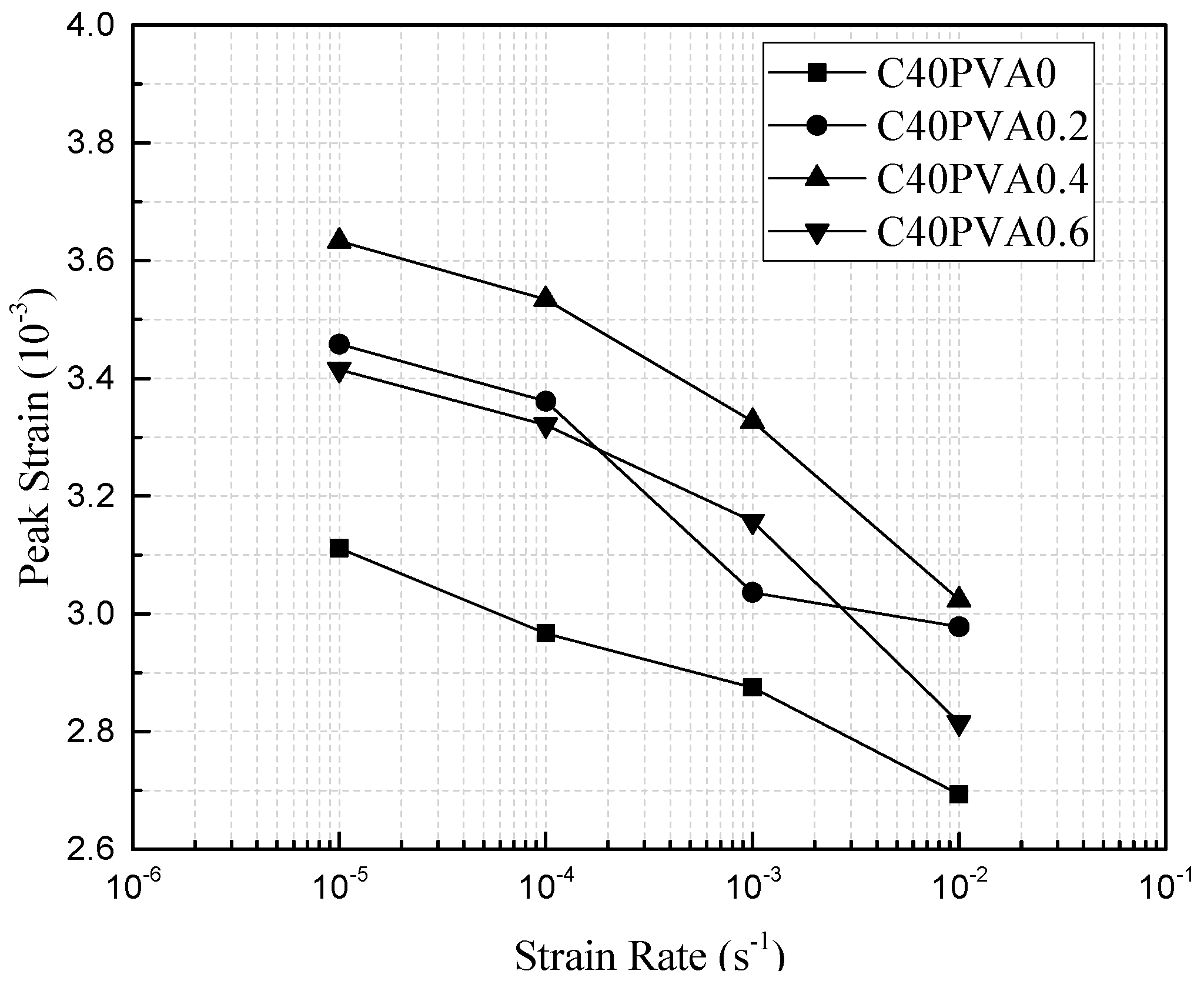
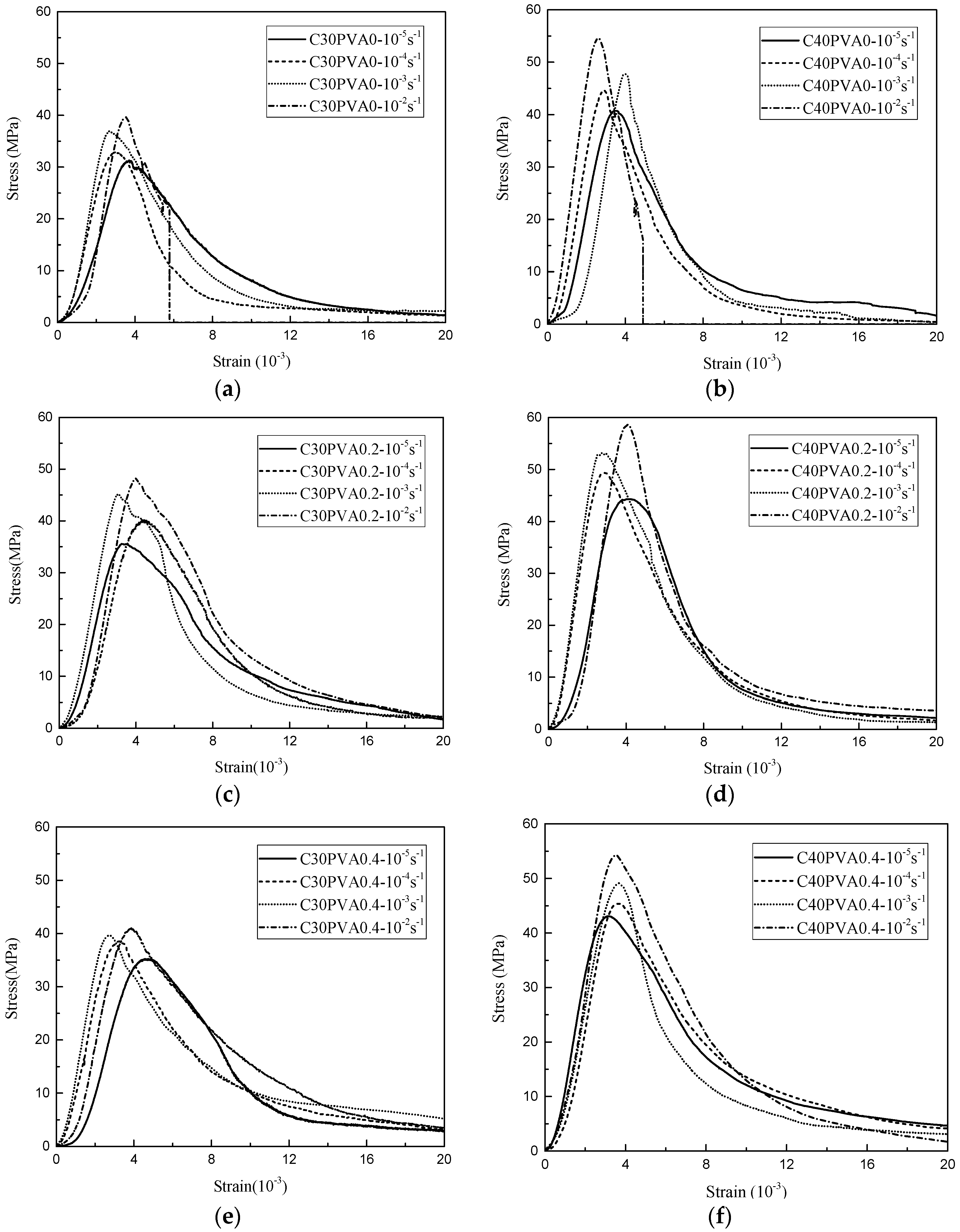

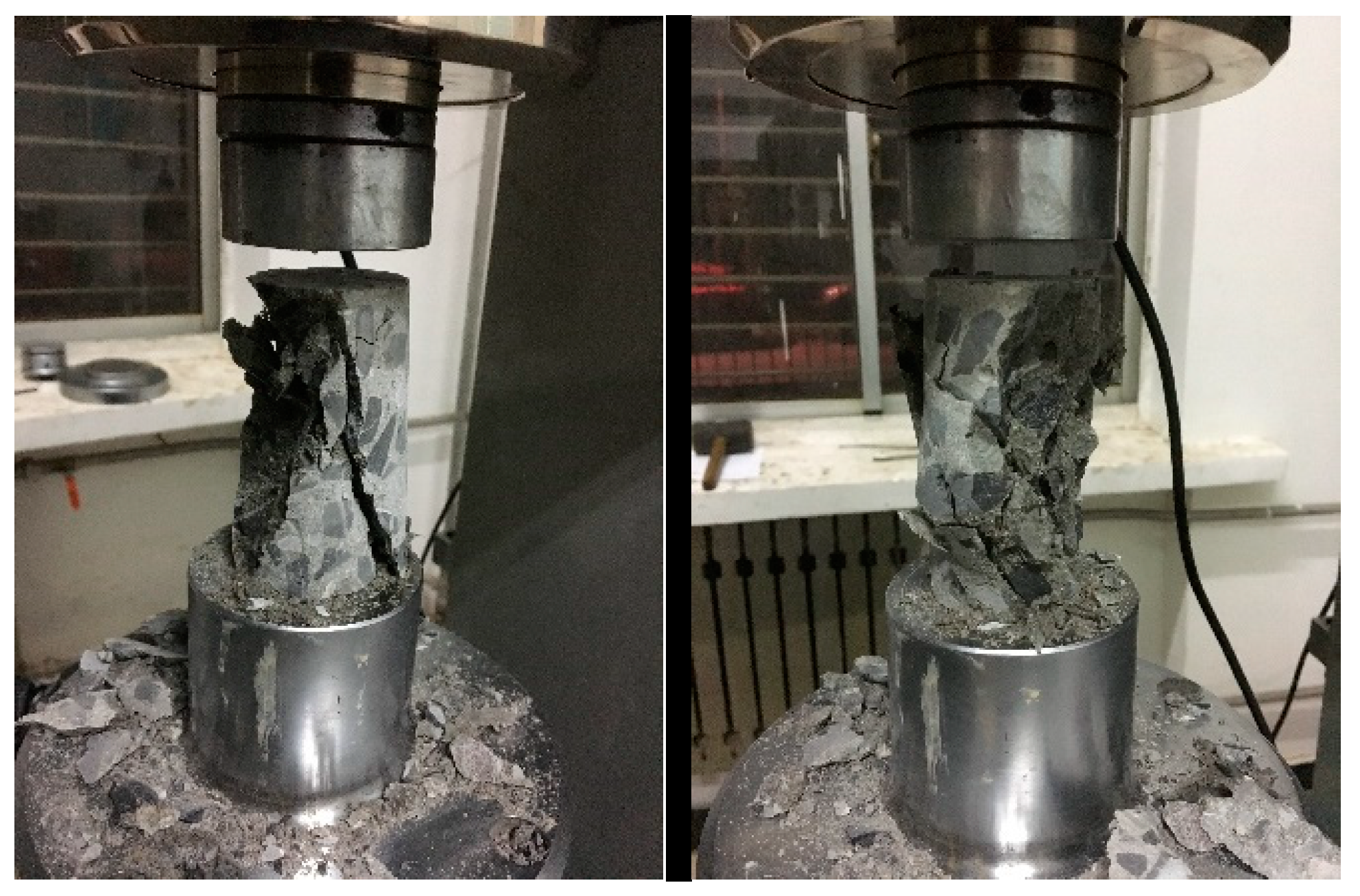
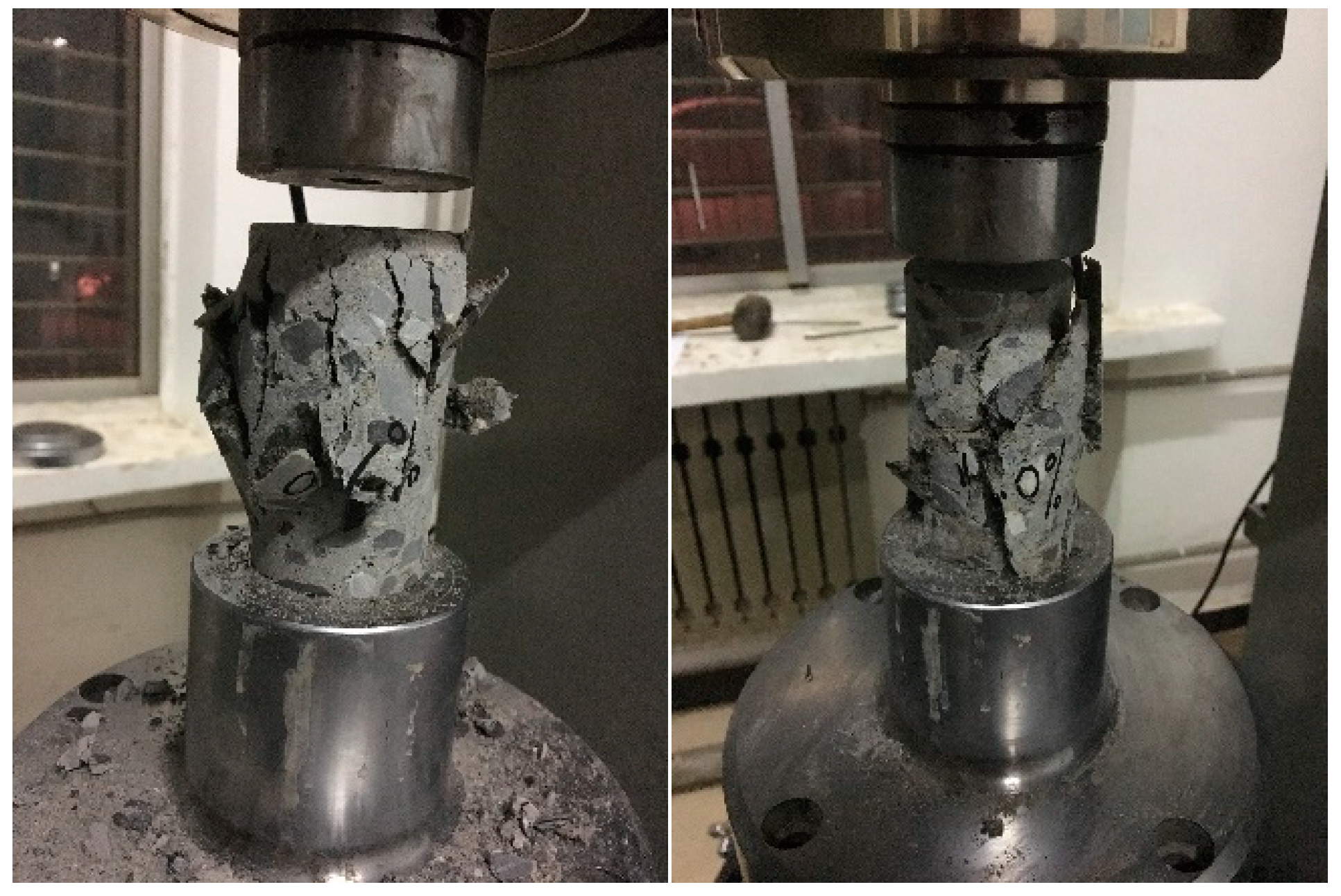
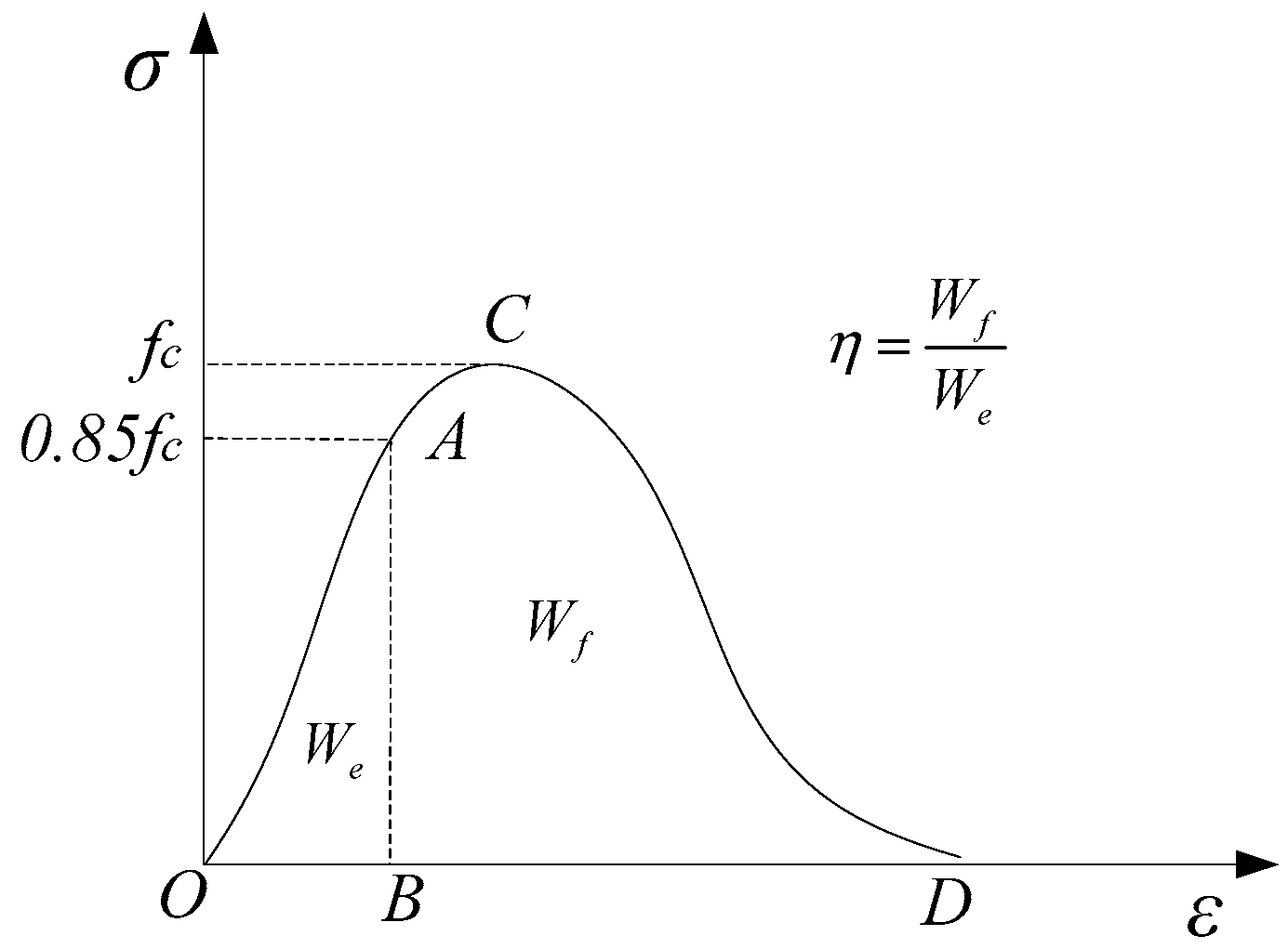


| Fiber Shape | Density (g/cm3) | Fiber Diameter (μm) | Fiber Length (mm) | Tensile Strength (MPa) | Elastic Modulus (GPa) | Elongation at Break (%) | Acid and Alkali Resistance |
|---|---|---|---|---|---|---|---|
| Bunchy monofilament | 1.30 | 15–25 | 12 | ≥1200 | ≥30 | 5–20 | Strong |
| Serials No. | Test Items | Standard Requirement | Measured Value | Individual Assessment |
|---|---|---|---|---|
| 1 | Tensile strength (MPa) | ≥1200 | 1721.2 | Qualified |
| 2 | Initial elastic modulus (GPa) | ≥30 | 35.7 | Qualified |
| 3 | Elongation at break (%) | 5–20 | 7.0 | Qualified |
| Type | Cement (kg) | Water (kg) | Fine Aggregate (kg) | Coarse Aggregate (kg) | W/C | Sand Ratio | PVA Volume Content |
|---|---|---|---|---|---|---|---|
| C30PVA0 | 377.6 | 200 | 643.1 | 1194.3 | 0.53 | 35% | 0% |
| C30PVA0.2 | 377.6 | 200 | 643.1 | 1194.3 | 0.53 | 35% | 0.2% |
| C30PVA0.4 | 377.6 | 200 | 643.1 | 1194.3 | 0.53 | 35% | 0.4% |
| C30PVA0.6 | 377.6 | 200 | 643.1 | 1194.3 | 0.53 | 35% | 0.6% |
| C40PVA0 | 438.8 | 215 | 611.17 | 1135.03 | 0.49 | 35% | 0% |
| C40PVA0.2 | 438.8 | 215 | 611.17 | 1135.03 | 0.49 | 35% | 0.2% |
| C40PVA0.4 | 438.8 | 215 | 611.17 | 1135.03 | 0.49 | 35% | 0.4% |
| C40PVA0.6 | 438.8 | 215 | 611.17 | 1135.03 | 0.49 | 35% | 0.6% |
| Type | Strain Rate (s−1) | Wf (J/m3) | We (J/m3) | Toughness Index |
|---|---|---|---|---|
| C30PVA0 | 10−5 | 201.21 | 29.02 | 6.93 |
| C30PVA0 | 10−4 | 157.87 | 25.06 | 6.30 |
| C30PVA0 | 10−3 | 160.90 | 29.24 | 5.50 |
| C30PVA0 | 10−2 | 112.61 | 28.41 | 3.96 |
| C30PVA0.2 | 10−5 | 237.59 | 28.59 | 8.31 |
| C30PVA0.2 | 10−4 | 203.66 | 28.95 | 7.03 |
| C30PVA0.2 | 10−3 | 252.82 | 40.15 | 6.30 |
| C30PVA0.2 | 10−2 | 244.93 | 50.11 | 4.89 |
| C30PVA0.4 | 10−5 | 286.49 | 29.64 | 9.66 |
| C30PVA0.4 | 10−4 | 288.44 | 34.27 | 8.42 |
| C30PVA0.4 | 10−3 | 259.54 | 34.39 | 7.60 |
| C30PVA0.4 | 10−2 | 233.84 | 36.57 | 6.39 |
| C30PVA0.6 | 10−5 | 266.11 | 25.28 | 10.53 |
| C30PVA0.6 | 10−4 | 317.60 | 35.56 | 8.93 |
| C30PVA0.6 | 10−3 | 263.17 | 31.09 | 8.47 |
| C30PVA0.6 | 10−2 | 259.54 | 34.79 | 7.46 |
| C40PVA0 | 10−5 | 198.86 | 30.50 | 6.52 |
| C40PVA0 | 10−4 | 200.75 | 35.28 | 5.69 |
| C40PVA0 | 10−3 | 190.13 | 38.66 | 4.92 |
| C40PVA0 | 10−2 | 163.00 | 44.82 | 3.64 |
| C40PVA0.2 | 10−5 | 269.46 | 35.58 | 7.57 |
| C40PVA0.2 | 10−4 | 297.19 | 41.69 | 7.13 |
| C40PVA0.2 | 10−3 | 327.58 | 47.43 | 6.91 |
| C40PVA0.2 | 10−2 | 298.17 | 52.14 | 5.72 |
| C40PVA0.4 | 10−5 | 332.30 | 34.11 | 9.74 |
| C40PVA0.4 | 10−4 | 320.76 | 37.03 | 8.66 |
| C40PVA0.4 | 10−3 | 312.84 | 47.58 | 6.58 |
| C40PVA0.4 | 10−2 | 270.63 | 51.37 | 5.27 |
| C40PVA0.6 | 10−5 | 362.71 | 35.42 | 10.24 |
| C40PVA0.6 | 10−4 | 351.34 | 37.54 | 9.36 |
| C40PVA0.6 | 10−3 | 347.59 | 41.10 | 8.46 |
| C40PVA0.6 | 10−2 | 338.79 | 47.57 | 7.12 |
© 2018 by the authors. Licensee MDPI, Basel, Switzerland. This article is an open access article distributed under the terms and conditions of the Creative Commons Attribution (CC BY) license (http://creativecommons.org/licenses/by/4.0/).
Share and Cite
Wu, Y.; Song, W.; Zhao, W.; Tan, X. An Experimental Study on Dynamic Mechanical Properties of Fiber-Reinforced Concrete under Different Strain Rates. Appl. Sci. 2018, 8, 1904. https://doi.org/10.3390/app8101904
Wu Y, Song W, Zhao W, Tan X. An Experimental Study on Dynamic Mechanical Properties of Fiber-Reinforced Concrete under Different Strain Rates. Applied Sciences. 2018; 8(10):1904. https://doi.org/10.3390/app8101904
Chicago/Turabian StyleWu, Yuexiu, Wanpeng Song, Wusheng Zhao, and Xianjun Tan. 2018. "An Experimental Study on Dynamic Mechanical Properties of Fiber-Reinforced Concrete under Different Strain Rates" Applied Sciences 8, no. 10: 1904. https://doi.org/10.3390/app8101904
APA StyleWu, Y., Song, W., Zhao, W., & Tan, X. (2018). An Experimental Study on Dynamic Mechanical Properties of Fiber-Reinforced Concrete under Different Strain Rates. Applied Sciences, 8(10), 1904. https://doi.org/10.3390/app8101904






